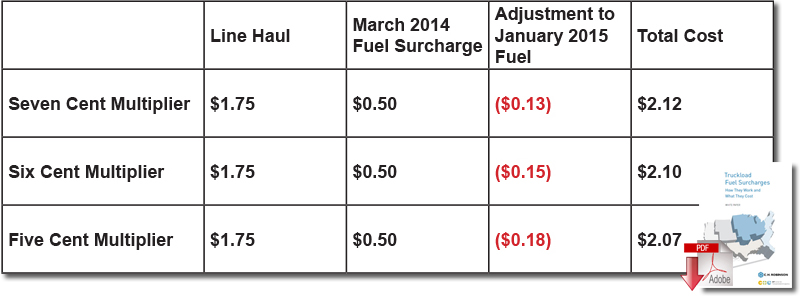Because fuel is a large part of the cost of truckload transportation, most carriers and shippers participate in a fuel program of some kind.
When fuel prices fluctuate significantly, like the decrease we’re experiencing now, it might be tempting to modify your fuel surcharge program.
However, the best strategy is to resist playing that game.
Here’s why.
The majority of fuel programs use a five, six, or seven cent multiplier. Simply put, for every five, six, or seven cent change in fuel prices, the fuel surcharge goes up or down a penny.
As we have discussed, an equitable fuel program involves more than understanding a carrier’s MPG and billable miles. You also need to understand how much dead head a carrier has and the difference between billable miles and actual miles. To learn more, read this post “Leveling the Surcharge Playing Field.”.
So let’s look at how big a swing there is between the most and least generous fuel programs. Say, for example, that your average rate per mile was $1.75 and you were paying $0.50 in fuel surcharge back in March. Your total cost would have been $1.75 line haul + $0.50 fuel surcharge = $2.25 total cost per mile. Now look where you end up using different multipliers.
There is only a 2.4% difference between the seven cent multiplier and the five cent multiplier. So it doesn’t matter if you were stingy or generous in the past with your multiplier; your reduction in total costs are similar. If you think that a different multiplier would better reflect your freight, I would encourage you to wait until you next scheduled procurement event to make that change.
You might also be tempted to change the index you are using to calculate fuel surcharges.
This will not work either, as all fuel indices we looked at are highly correlated, and over longer periods of time, their movements are virtually the identical as we have discussed in Truckload Fuel Surcharges: How They Work and What They Cost.
This white paper also points out that shippers are likely to save more on transportation by employing other methods that develop stronger relationships with carriers and make freight more attractive to them than they are by playing the fuel surcharge game.
Consider, too, that a recent Logistics Management article reported that carriers’ overall cost of doing business are rising, despite the dip in diesel fuel costs; their savings are nearly entirely offset by the drop in fuel surcharges and other increasing expenses.
I can’t tell you where fuel is going, but I can tell you that if you are using a standard fuel program, you are protected as much as possible from changes in fuel prices on truckload freight.
Related: Fuel Dip “Savings” Offset By Surge in Costs for Drivers, Equipment, and Healthcare

Article topics
Email Sign Up


















